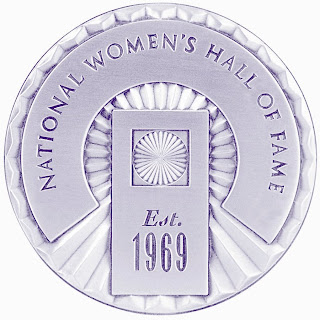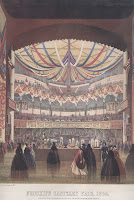 To coincide with Women’s History Month, the National Women’s Hall of Fame announces its 2009 Inductees. Included in the group of ten outstanding American women are world-renowned artist Louise Bourgeois, biochemist Dr. Mildred Cohn, attorney and women’s rights activist Karen DeCrow, domestic violence advocate Susan Kelly-Dreiss, attorney and social justice activist Dr. Allie B. Latimer, ecologist and limnologist Dr. Ruth Patrick, and atmospheric scientist Dr. Susan Solomon. These women, along with three historic figures, will be inducted during a weekend of celebration to be held in Seneca Falls, New York on October 10-11, 2009. Seneca Falls was the location of the first women’s rights convention, held in 1848. The event began a 72-year struggle for women’s suffrage.
To coincide with Women’s History Month, the National Women’s Hall of Fame announces its 2009 Inductees. Included in the group of ten outstanding American women are world-renowned artist Louise Bourgeois, biochemist Dr. Mildred Cohn, attorney and women’s rights activist Karen DeCrow, domestic violence advocate Susan Kelly-Dreiss, attorney and social justice activist Dr. Allie B. Latimer, ecologist and limnologist Dr. Ruth Patrick, and atmospheric scientist Dr. Susan Solomon. These women, along with three historic figures, will be inducted during a weekend of celebration to be held in Seneca Falls, New York on October 10-11, 2009. Seneca Falls was the location of the first women’s rights convention, held in 1848. The event began a 72-year struggle for women’s suffrage.
The 2009 Inductees are:
Louise Bourgeois (1911 – ) One of the world’s most preeminent artists, Louise Bourgeois’s career has spanned over seven decades. Best known for her work as a sculptor, Bourgeois uses a variety of materials including wood, metal, marble and latex to create works often reflective of her childhood experiences and life relationships. In 1982, Bourgeois became the first female artist to be given a retrospective at The Museum of Modern Art in New York, and in 1997 she was awarded the National Medal of Arts. Her varied and extensive body of work has been displayed in the collections of major museums worldwide.
Dr. Mildred Cohn (1913 – ) A groundbreaking scientist in several important areas of biological research, Dr. Mildred Cohn pioneered research that helped form the scientific understanding of mechanisms of enzymatic reactions and the methods of studying them. In 1946, she introduced the use of isotopic oxygen 18 to study metabolic processes and enzyme mechanisms. She later applied nuclear magnetic resonance (NMR) and electron paramagnetic resonance (EPR) to investigate metabolism and metabolic intermediates. Dr. Cohn has published more than 150 scientific papers and has received several awards for her work, including the National Medal of Science in 1982.
Karen DeCrow (1937 – ) A nationally recognized attorney, author and activist, Karen DeCrow is one of the most celebrated leaders of the women’s movement. From 1974-1977, she served as the National President of the National Organization for Women (NOW), where she was instrumental in obtaining significant legislative and legal gains and tirelessly advocated on behalf of the Equal Rights Amendment (ERA). Ms. DeCrow has written numerous books and articles and has lectured throughout the world on topics such as law, gender equality, and politics. In 1970, she served as National Coordinator of the Women’s Strike, and in 1988 she co-founded World Women Watch.
Susan Kelly-Dreiss (1942 – ) For over 30 years, Susan Kelly-Dreiss has worked to enact legal protections, implement innovative services and heighten public awareness on behalf of battered women and their children. In 1976, Ms. Kelly-Dreiss lobbied for passage of Pennsylvania’s first domestic violence law, and later that same year, she co-founded the nation’s first domestic violence coalition – the Pennsylvania Coalition Against Domestic Violence (PCADV). She was a founding member of the National Network to End Domestic Violence, and has played a key role in drafting federal legislation including the Federal Violence Prevention and Services Act and the Violence Against Women Act.
Dr. Allie B. Latimer (19xx – ) An attorney, civil rights activist and humanitarian, Dr. Allie B. Latimer was instrumental in organizing Federally Employed Women (FEW) in 1968, and served as the organization’s founding president until 1969. In 1977, as a federal attorney, Dr. Latimer was the first African American and first woman to serve as General Counsel of a major federal agency as well as the first woman to attain the GS-18 salary level at the General Services Administration. She was also recognized as part of the “second wave of feminist pioneers” by the Veteran Feminists of America (VFA).
Emma Lazarus (1849 – 1887) “Give me your tired, your poor, / Your huddled masses yearning to breathe free.” These famous words from The New Colossus, were written by Emma Lazarus, one of the first successful Jewish American authors. Originally created in 1883, the sonnet was later engraved in bronze and placed at the base of the Statue of Liberty. Throughout her lifetime, Lazarus authored and published numerous poems, essays, letters, short stories and translations. She was an important forerunner of the Zionist movement, having argued for the creation of a Jewish homeland thirteen years before the term Zionist was even coined.
Dr. Ruth Patrick (1907 – ) A pioneer in the field of limnology – the scientific study of the life and phenomena of fresh water, especially lakes and ponds – Dr. Ruth Patrick pioneered techniques for studying the biodiversity of freshwater ecosystems and provided methods needed to monitor water pollution and understand its effects. Dr. Patrick is credited, along with Rachel Carson, as being largely responsible for ushering in the current worldwide concerns with ecology. She was the first female elected chair of the board of the Academy of Natural Sciences and received the National Medal of Science in 1996.
Rebecca Talbot Perkins (1866 – 1956) In 1927, a time when very few agencies existed to promote adoption, Rebecca Talbot Perkins joined with the Alliance of Women’s Clubs of Brooklyn to create The Rebecca Talbot Perkins Adoption Society. Later known as Talbot Perkins Children’s Services, the organization provided foster care and adoption services to countless families across the country for 75 years. Throughout her lifetime, Perkins was active in various charitable and civic causes as a member of the Brooklyn Women’s Suffrage Society, Chair of the Alliance of Women’s Clubs of Brooklyn, Vice President of the Memorial Hospital for Women and Children, and Director of the Welcome Home for Girls.
Dr. Susan Solomon (1956 – ) An internationally recognized leader in the field of atmospheric science, Dr. Susan Solomon pioneered the theory explaining how and why the ozone hole occurs in Antarctica, and obtained some of the first chemical measurements that established man-made chlorofluorocarbons (CFCs) as its cause. Dr. Solomon is the recipient of numerous awards, including the 1999 National Medal of Science and the Asahi Foundation of Japan’s Blue Planet Prize in 2004. From 2002-2008, Dr. Solomon served as the co-chair of the Intergovernmental Panel on Climate Change (IPCC), which shared the Nobel Peace Prize with Albert Gore, Jr. in 2007. Dr. Solomon’s current research as a senior scientist with the National Oceanic and Atmospheric Administration focuses on climate change, ozone depletion and the links between the two.
Katherine Stoneman (1841 – 1925) Katherine “Kate” Stoneman was the first woman admitted to practice law in New York State. In 1885, she became the first female to pass the New York State Bar Exam, but her 1886 application to join the bar was rejected because of her gender. Stoneman immediately launched a lobbying campaign to amend the Code of Civil Procedure to permit the admission of qualified applicants without regard to sex or race, and was successfully admitted to the bar later the same month. In 1898, she became the first female graduate of Albany Law School, and was the first woman to receive a bachelor’s degree from any department of Union University.
These ten women will join the 226 already inducted into the Hall, the first national membership organization recognizing and celebrating the accomplishments of great Am
erican women.
For more information on the Hall of Fame or its activities, call (315)568-8060 or visit their website, www.greatwomen.org.
 The Brooklyn Museum’s First Saturdays events attract thousands of visitors to free programs of art and entertainment each month. March’s First Saturday celebrates the talent and power of women throughout history. Highlights include the new exhibition Kiki Smith: Sojourn on view in the Elizabeth A. Sackler Center for Feminist Art- a special performance by renowned Haitian vocalist Emeline Michel- a screening of Deepa Mehta’s Water- a discussion by author Staceyann Chin of her new book The Other Side of Paradise- and a dance party hosted by DJ Mary Mac.
The Brooklyn Museum’s First Saturdays events attract thousands of visitors to free programs of art and entertainment each month. March’s First Saturday celebrates the talent and power of women throughout history. Highlights include the new exhibition Kiki Smith: Sojourn on view in the Elizabeth A. Sackler Center for Feminist Art- a special performance by renowned Haitian vocalist Emeline Michel- a screening of Deepa Mehta’s Water- a discussion by author Staceyann Chin of her new book The Other Side of Paradise- and a dance party hosted by DJ Mary Mac.







